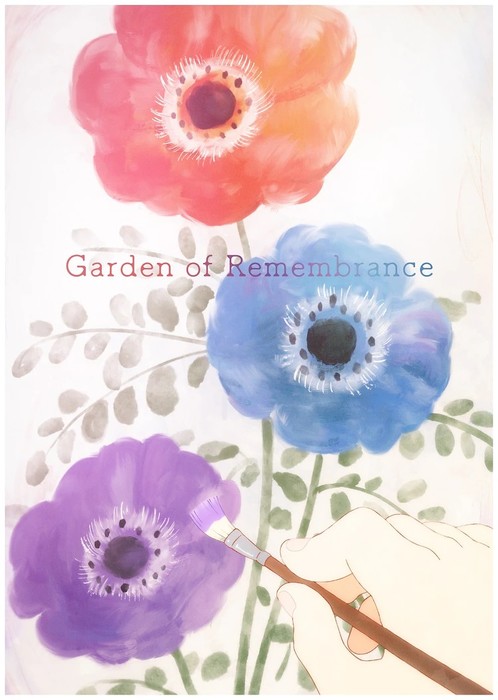INTERVIEW: Garden of Remembrance Director Naoko Yamada
by Andrew Osmond, Naoko Yamada's visit to Britain in October wasn't the feted director's first trip to the island. Yamada came to Britain as a guest of honor for the Scotland Loves Anime festival back in 2012 where she participated in a screening for the K-ON! feature film. Serendipitously, the film itself also brings London to the screen as everyone's favorite Light Music Club leave Japan for the UK.
Naoko Yamada's visit to Britain in October wasn't the feted director's first trip to the island. Yamada came to Britain as a guest of honor for the Scotland Loves Anime festival back in 2012 where she participated in a screening for the K-ON! feature film. Serendipitously, the film itself also brings London to the screen as everyone's favorite Light Music Club leave Japan for the UK.
Ten years later, Yamada was once more the guest at the Scotland Loves Anime event. In an extended Q&A session, the director fondly remembered her early experiences of Britain. For example, she learned that Scottish people don't like hearing that Nessie isn't real, that the receptacles in Hyde Park which look like letterboxes are actually catering for dogs, and that Marmite (an infamous British food spread) doesn't taste very nice. A majority of the audience agreed with her on the last point.
However, Yamada's new visit wasn't just for nostalgia. She was presenting the world premiere of Garden of Remembrance, her 17-minute film made at Science SARU. It's a film about loss, and what comes after loss; it shows a lonely girl's repetitive life when a precious person is gone, and how that life is suddenly reframed. It's an extended music video, made in collaboration with the singer Lovely Summer-chan and the manga artist Etsuko Mizusawa.
A couple of days before the festival, Yamada stopped off in London, where I was able to interview her. I asked her about her new film, and her recent work with the Science SARU studio. However, I also took the opportunity to ask about some of Yamada's beloved earlier works at Kyoto Animation, K-ON! included.
You've worked at both Kyoto Animation and Science SARU, two studios strongly associationed with particular ‘looks’ – fans can often tell a Kyoto Animation work or a Science SARU work just by looking at them. You often are associated with a strong aesthetic of your own, particularly with the way your characters move on screen. I wondered if you had any comments on that; for example, if you feel that you have taken your sensibility from one studio to another?
Yamada: At Kyoto Animation, I really learned how to portray human emotions, and what was going on in the characters' minds and hearts. It wasn't just an animation; it was more about how to portray what they were going through, as if they were real-life characters. The aim wasn't to create an animation; it was more about how we could treat them as real beings, to create the real life. Our role was to become a director of photography rather than an animator – to become a camera person and let the characters just go through their life. So that was what we explored – that was the challenge.
 Then when I worked on The Heike Story with Science SARU, the difference between the two studios was quite stark, because Science SARU really embraces the pleasure of making animation, everything is about being happy creating animation. I was curious myself about how those two [approaches] would marry up: the characters as real-life beings, as well as the pleasure of making animation – what kind of chemistry would be born out of the experience of those two [things].
Then when I worked on The Heike Story with Science SARU, the difference between the two studios was quite stark, because Science SARU really embraces the pleasure of making animation, everything is about being happy creating animation. I was curious myself about how those two [approaches] would marry up: the characters as real-life beings, as well as the pleasure of making animation – what kind of chemistry would be born out of the experience of those two [things].
So when I worked on The Heike Story, I consciously stopped becoming the camera person, almost. I did that again more consciously for Garden of Remembrance as well – it's an evolution of what was done for The Heike Story. That is something that I'm still challenging myself with; Garden of Remembrance is my second attempt at doing that. However, Garden of Remembrance is shot from the “I” perspective, so it's a mixture of the two, almost; not simply being a camera person, but through that perspective of looking in. It's the male character who is looking in.
So Garden of Remembrance is from the point of view of the male character?
Yamada: Yes and no. This film is really being portrayed from three different perspectives. The first one is the male character, the character who no longer exists in the world that is being depicted; the one who has lost his girlfriend, but is looking in on the girlfriend. The second perspective is that of the girlfriend, and the third perspective is another female character.
Many people comment on the importance of legs and feet in your anime, and the girlfriend character in Garden of Remembrance has rather chubbier-looking legs than most girls in anime. I've read that you asked Etsuko Mizusawa to design the character in a more chubby way. Can you comment on why you chose that kind of design?
Yamada: It wasn't so much that the chubbier-looking legs came from the designer. It was that I very much liked her designs and her drawings and that's why I approached her to be part of this project. The girls that she depicts tend to be chubbier in general, as you mentioned, much more meaty-looking than anime characters in general. They aren't in line with what is being perceived as ideal by their societal standards, but the texture, what the characters evoke from the drawings… You can almost feel that you can stroke their skin, or smell them after they've woken up. You can probably see them dribble. It feels very real; I really liked that essence, so that's why I approached her,
I once interviewed you about A Silent Voice and I asked you if that was a new kind of film for you, compared to what you had done previously. You said that you thought it wasn't so different. With Garden of Remembrance, I'd like to ask the same question – do you see it as a new direction for you?
Yamada: I think the core of what I want to do, what I'm trying to achieve, will remain the same. The reason why I create anime is because I have a huge respect for human beings in general; what everyone thinks, what people are feeling, what they're going through emotionally. That is something that I deeply respect, and I really want to respect the characters' privacy, but I also want to be respectful when I'm depicting them. I don't think that would change ever, really, in what I want to do. It's always in my mind that I do respect them when I'm creating animation.
In this collaboration with Science SARU, and probably going forward in anything that I do, I think the genres might change, the protagonists and their personalities might change, but the core part of what I want to do will always remain the same.
 I wanted to ask a couple of questions relating to some of your earlier work. Some anime fans claim that series such as Lucky Star and K-ON! were part of a trend in the 2000s towards lighthearted anime that focused on groups of school-aged girls. Would you agree that this was a trend at the time and if so, why do you think that the trend happened?
I wanted to ask a couple of questions relating to some of your earlier work. Some anime fans claim that series such as Lucky Star and K-ON! were part of a trend in the 2000s towards lighthearted anime that focused on groups of school-aged girls. Would you agree that this was a trend at the time and if so, why do you think that the trend happened?
Yamada: Lucky Star was by other directors [Yasuhiro Takemoto and Yutaka Yamamoto], but they're works that I worked on when I was at Kyoto Animation. We tended to use a lot of high-school characters, and maybe people might see the trend at the time, see it as almost like a zeitgeist. But I personally don't really try and make an animation about the time that we were living in; I try not to reflect so much on a trend. It's because of what I just said: I tend to value what the characters are going through emotionally. That doesn't change, really, in whatever time that we are living in. So I try not to focus too much on the trends.
Following on from the last question, it's sometimes claimed K-ON! would have been commissioned on the assumption that male anime fans would watch it. However, it was also reported that a high proportion of K-ON!'s actual viewers in Japan were female. Do you have any comments on this?
Yamada: Yes, you are correct in what the producers were initially aiming for. However, I wasn't aware at the time when I was making K-ON! that that was the direction they were aiming for. All I was focused on was… I was genuinely impressed by how cute and wholesome the girls were, and that was something that I wanted to encompass to the audience. I think it was great that the producers didn't really disclose their commercial direction or their motives that they had; probably that was the source of K-ON!'s success.
When you were in Glasgow in 2017, you said that A Silent Voice involved romantic love, but the love story was not the most important element. Would you say that Liz and the Blue Bird is more of a love story, and would you be happy to describe it as a gay love story where at least one of the girls, Mizore, is gay?
Yamada: On Liz and the Blue Bird, as well as Tamako Love Story, a lot of people read into that as a gay love story, as you have mentioned. But that wasn't so much the intention. Just to explain a bit more, it wasn't so much the representation of one sexual orientation, but it was a representation of adolescence, what the characters tend to go through at that time. During those years of our lives, everything seems intensified, whether it be friendships, or the reliance on a certain person, or the dependency…. Because of the limitations of the worlds that the characters live in as well. I just wanted to describe how complex living your teenage years could be, and what they tend to go through.
So it wasn't a simple depiction of, “Yes, they're gay and this is their love story,” because I can't comment on what kind of person they would fall in love with in the future, or who they will become. It's a portrayal of what they were at the time. The answer is, it is quite complicated.
One last question: it's been reported that Science SARU will make a feature film in the future, directed by yourself. Is that correct?
Yamada: Yes, we are indeed working on a feature-length project, Science SARU and myself. I'm working on the storyboard at the moment. It's a huge task and it's on my mind a lot.
discuss this in the forum (7 posts) |